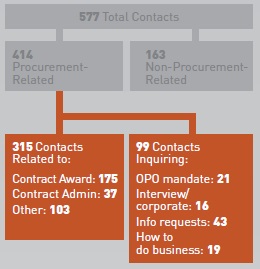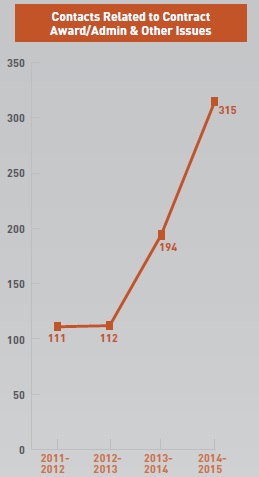Educate, Facilitate and Investigate
Whether the Office is carrying out an element of its legislated mandate or dealing with an issue informally, our approach is always focused on promoting fairness, openness and transparency in federal procurement. Part of the way in which we do this is by focusing on the following three strategic objectives, or pillars:
- Educate
Raise awareness of procurement issues and exchange information - Facilitate
De-escalate disputes and help resolve issues - Investigate
Examine and review procurement issues
The following sections of this report describe the actions undertaken by Office of the Procurement Ombudsman (OPO) staff, keeping with these three pillars — Educate, Facilitate and Investigate. The pillars also provide the structure for this report and, accordingly, an understanding of the Office’s activities, including how we handled the 414 procurement-related contacts received last year.
Educate
What We Did to Raise Awareness of Procurement Issues and Exchange Information

Image Description
This diagram identifies the number of total contacts received by the Office of the Procurement Ombudsman in the 2014-2015 fiscal year as 577. This total number is then broken down below into procurement-related contacts (414) and non-procurement-related contacts (163). Of the 414 Procurement-related contacts, 315 are identified as related to contract award (175), contract administration (37) and other (103). The remaining 99 are described as contacts inquiring about Office of the OPO mandate (21), interview/corporate (16), information requests (43) and how to do business (19).
The Office continued to experience an increase in the number of procurement-related contacts. These are contacts from people making procurement - or OPO-related inquiries or wanting to share procurement-related issues or concerns with us. For example, it is not uncommon for suppliers to contact the Office because they have had little success in obtaining answers from a department about what they believe are basic questions regarding a solicitation or about a particular procurement process. It is also not uncommon for suppliers to be exasperated, feeling they simply are not getting anywhere with their query with a department and not knowing where else to turn. Our objective in dealing with these types of contacts is quite simple—to listen and then find a way to address the question as quickly and effectively as possible. In most cases, answering suppliers’ questions by providing straightforward, basic information about how federal procurement works is all it takes.
This year, the Office received 414 procurement-related contacts from suppliers and government officials. Of these 414, 99 (24%) were inquiries where the Office provided information on topics such as our mandate or general questions about whom to contact in order to understand how to do business with the federal government.
The balance of 315 contacts was, by and large, primarily from Canadian suppliers regarding somewhat more complex issues. We were able to address some of these contacts by providing information on such things as why a federal department cannot simply renew a contract as often occurs in the private sector, or by explaining the rules surrounding a procurement vehicle such as a supply arrangement or standing offer.
Of these 315 contacts, 175 (56%) raised issues related to the award of a federal contract, and 37 (12%) spoke to us about issues related to the administration of a contract. The remaining 103 (33%) contacts provided feedback on other aspects of federal procurement, for example, suppliers reporting what they believed to be systemic procurement issues and suggesting the issue be reviewed by the Ombudsman.
“Your website was very clear and the response to my inquiry was prompt. I had a pleasant and productive conversation with [the OPO representative] the following day and felt that my questions were answered and I was much better informed about the contracting process.”
– Supplier
As illustrated in Diagram 3, these 315 contacts represent an increase of 121 (62%) over the previous year and an increase of 204 (184%) since 2011-2012.
It was not uncommon for many of the individuals who contacted the Office to raise more than one issue. Diagram 4 lists the most common procurement-related issues raised through these contacts. The Office has seen very little variation in the types of issues raised over the past four years. The top three most common procurement-related issues raised in 2014-2015, as listed in Diagram 4, have been among the top five issues raised since 2011-2012.
Diagram 3

Image Description
This diagram illustrates a four year comparative in the number of contacts related to contract award, administration and other issues. The four years are illustrated from left (2011-2012) to right (2014-2015). In the 2011-2012 fiscal year, there were 111; in 2012-2013, there were 112; in 2013-2014, there were 194; and in 2014-2015, there were 315.
Diagram 4
Most Common Procurement-Related Issues 2014-2015
- Procurement strategy and related issues (e.g. competitive vs. non-competitive, type of contracting vehicle)
- Evaluation of bids (e.g. undisclosed/changed criteria, inconsistent application of criteria)
- Evaluation and selection plan and related issues (e.g. bias for or against supplier/class of suppliers, vague or unclear, excessive or restrictive criteria, unbalanced weighting)
- Security clearance and related issues (e.g. delays, one department accepting the security clearance but others not)
- Solicitation document (e.g. restrictive or conflicting terms and conditions)
The other primary component of our Educate pillar was our ongoing, concerted effort to reach out to the approximately 1.1 million Canadian businesses that may not have heard of the Office, so as to ensure they were aware of OPO and our services. The benefits of this sustained outreach effort were twofold; it continued to prove to be productive in reaching numerous businesses that had not heard of the Office and it provided yet another means for suppliers to speak to us about their experiences with federal procurement. Our outreach efforts focused on connecting with:
- suppliers at approximately thirty town hall sessions and conferences, and eight online town hall discussions;
- federal procurement specialists via presentations focusing on OPO’s mandate and dispute resolution services and at information-exchange meetings; and
- suppliers, federal departments, parliamentarians, associations and other stakeholders via Twitter, Wikipedia, website updates, newsletters and notifications to OPO’s distribution list members.
Suppliers’ concerns
Some examples of supplier concerns with federal procurement brought to our attention through outreach activities include:
- The disconnect between high forecasted business volumes communicated for standing offers and supply arrangements and much lower actual volumes;
- Communication barriers and access to procurement-related information;
- The impact of bundling (i.e. including multiple goods or services within one solicitation) and requirements for country-wide delivery capacity;
- Potential overuse of the CORCAN program as a procurement vehicle rather than using pre-existing standing offers and supply arrangements and its impact on local industry; and
- Costly liability insurance as a bidding condition.
Federal officials’ concerns
Similarly, the Office has had the opportunity to meet with federal officials involved in procurement who also relayed issues, some of which include:
- The effects of a number of concurrent pressures on the federal procurement workforce, including demographics (aging), budgetary restraints and an increase in the volume of low-dollar-value procurement managed by departments;
- Challenges associated with the growing number of trade agreements (e.g. limited guidance on how to comply, differences between departmental approaches);
- Challenges associated with integrity provisions (e.g. impact on costs, timelines and supplier base); and
- Communication challenges between procurement personnel and program managers.
“Your presentation regarding the Office of the Procurement Ombudsman’s mandate and its Dispute Resolution Services was very informative and well received by the various federal government departments in attendance. Hopefully the issues and discussion raised during the feedback session will be useful to you and your organization.”
– Ontario Chapter of the Canadian Institute for Procurement and Materiel Management
Concerns shared by suppliers and federal officials
Finally, we were made aware of concerns shared by both suppliers and federal officials:
- The impact of delays in the security clearance process, including:
- time required to obtain clearance;
- difficulty obtaining sponsors;
- clarity of available information;
- departments potentially defaulting to lower security requirements rather than conducting a risk assessment;
- risks departments face by failing to assign appropriate security requirements as a means to avoid the lengthy process;
- Need for greater standardization of procurement documents and processes;
- Challenges related to monitoring vendor performance (departments) and frustration with the fact that suppliers are awarded contracts in spite of previous poor performance (suppliers).
In dealing with the 315 procurement-related contacts, the Office’s approach in providing straightforward, basic information about how federal procurement works was often all it took to deal with the issue raised. And while this Educate pillar is always the starting point in responding to a contact, there are instances where OPO is called upon to help facilitate the resolution of procurement issues. The following section of the report outlines our activities under the Facilitate pillar.
E-Procurement - Are we being left behind?
Electronic procurement (e-procurement) has become fairly common place in many countries. There are several examples of public and private entities transforming their entire procurement approach by moving to electronic means to process and manage procurement.
E-procurement has been shown to provide significant benefits, including:
- Cost reductions associated with reduced processing times, transaction costs, pricing and paper use.
- Centralized database—all the information required to plan, solicit, award and administer a contract is managed on one platform.
- Better control over and management of the contracting process, through the use of functions such as budget monitoring, invoice processing and workflow validation.
- Better file tracking and visibility—files cannot “sit” on someone’s desk or get lost in the mail.
- Single entry point for all users—suppliers can access and update their credentials in the same system that procurement officers use to manage procurement.
- Increased efficiency and accuracy over the entire procurement process—since all of the information is on one system, reporting requirements become an automated function.
Countries with e-procurement have experienced increased efficiency and lower transaction costs, heightened public procurement monitoring using automated procedures (hence less opportunity for fraud and corruption) and, ultimately greater transparency.
In this day and age of exponential technological growth, other jurisdictions are embracing the benefits of e-procurement. In Canada, federal procurement as a whole has progressed to the point where bids are electronically solicited and contract amendments can be sent by email.
- Date modified: